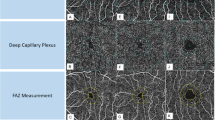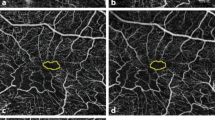Abstract
Purpose
To quantify the extent and depth of distortion of the foveal capillary architecture due to traction of an idiopathic epiretinal membrane (ERM) using optical coherence tomography angiography (OCT-A).
Methods
Multimodal imaging including OCT-A (Angiovue, Optovue) was performed in 42 eyes with idiopathic ERM (72.4 years ±6.8). Best corrected visual acuity (BCVA), OCT-A vessel density of the foveal (VDfo) and parafoveal (VDp) region were assessed. Based on 6 × 6-mm2 OCT-A images, a macular vessel density ratio (MVR = VDfo/VDp) was calculated for the superficial (s), deep (d) and full-thickness (f) slabs to assess a depth-resolved, non-invasive evaluation of foveal distortion. The acquired data were subdivided in a patient group with mild and significant BCVA reduction due to ERM. Data was compared to age-matched healthy controls.
Results
In all three slabs, MVR was significantly smaller in the control group in comparison with the ERM group: MVRs: 0.63 ± 0.1 vs 0.83 ± 0.1 (p > 0.001); MVRd: 0.60 ± 0.1 vs 0.73 ± 0.1 (p < 0.001); MVRf: 0.68 ± 0.1 vs 0.82 ± 0.1 (p < 0.001). Group 1 (BCVA <0.4 LogMar) showed a significantly higher MVR in comparison with the control group in the superficial plexus only: MVRs: 0.64 ± 0.1 vs 0.78 ± 0.1 (p < 0.001); MVRd: 0.60 ± 0.1 vs 0.65 ± 0.2 (p = 0.3); MVRf: 0.68 ± 0.1 vs 0.77 ± 0.1 (p = 0.01). However, group 2 (BCVA > = 0.4 LogMar) showed a significantly higher MVR in all three slabs: MVRs: 0.64 ± 0.1 vs 0.86 ± 0.1 (p < 0.001); MVRd: 0.60 ± 0.1 vs 0.77 ± 0.2 (p < 0.001); MVRf: 0.68 ± 0.1 vs 0.85 ± 0.1 (p < 0.001).
Conclusion
Assessing MVR using OCT-A may serve as a tool to quantify the extent and depth of distortion of the foveal capillary architecture due to traction of ERM. BCVA reduction appears to be associated with extent and depth of distortion.


Similar content being viewed by others
References
Compera D, Entchev E, Haritoglou C, Scheler R, Mayer WJ, Wolf A et al (2015) Lamellar hole-associated Epiretinal proliferation in comparison to Epiretinal membranes of macular Pseudoholes. Am J Ophthalmol 160(2):373–84.e1
Dell’omo R, Cifariello F, Dell’omo E, De Lena A, Di Iorio R, Filippelli M et al (2013) Influence of retinal vessel printings on metamorphopsia and retinal architectural abnormalities in eyes with idiopathic macular epiretinal membrane. Invest Ophthalmol Vis Sci 54(12):7803–7811
McDonald HR, Verre WP, Aaberg TM (1986) Surgical Management of Idiopathic Epiretinal Membranes. Ophthalmology 93(7):978–983
Yang HK, Kim SJ, Jung YS et al (2011) Improvement of horizontal macular contraction after surgical removal of epiretinal membranes. Eye 25:754–761
Kofod M, La Cour M (2012) Quantification of retinal tangential movement in epiretinal membranes. Ophthalmology 119:1886–1891
Weinberger D, Stiebel-Kalish H, Priel E et al (1999) Digital red-free photography for the evaluation of retinal blood vessel displacement in epiretinal membrane. Ophthalmology 106:1380–1383
Rodrigues IA, Lee EJ, Williamson TH (2016) Measurement of retinal displacement and metamorphopsia after epiretinal membrane or macular hole surgery. Retina 36(4):695–702
Romano MR, Cennamo G, Amoroso F, Montorio D, Castellani C, Reibaldi M, Cennamo G (2016a) Intraretinal changes in the presence of epiretinal traction. Graefes Arch Clin Exp Ophthalmol. doi:10.1155/2015/372564
Yagi T, Sakata K, Funatsu H, Hori S (2012) Evaluation of perifoveal capillary blood flow velocity before and after vitreous surgery for epiretinalmembrane. Graefes Arch Clin Exp Ophthalmol 250(3):459–460
Jia Y, Bailey ST, Hwang TS, McClintic SM, Gao SS, Pennesi ME et al (2015) Quantitative optical coherence tomography angiography of vascular abnormalities in the living human eye. Proc Natl Acad Sci U S A 112(18):E2395–E2402
Mori K, Gehlbach PL, Sano A, Deguchi T, Yoneya S (2004) Comparison of epiretinal membranes of differing pathogenesis using optical coherence tomography. Retina 24:57–62
Zhang X, Iverson SM, Tan O, Huang D (2015) Effect of signal intensity on measurement of ganglion cell complex and retinal nerve fiber layer scans in Fourier-domain optical coherence tomography. Transl Vis Sci Technol 4(5):7
Ghazi-Nouri SM, Tranos PG, Rubin GS, Adams ZC, Charteris DG (2006) Visual function and quality of life following vitrectomy and epiretinal membrane peel surgery. Br J Ophthalmol 90(5):559–562
Lee SM, Pak KY, Kwon HJ, Park SW, Lee JE, Byon IS (2017) Association between tangential contraction and early vision loss in idiopathic epiretinal membrane. Retina. doi:10.1097/IAE.0000000000001559 [Epub ahead of print]
Spaide RF, Fujimoto JG, Waheed NK (2015) Image artifacts in optical coherence tomography angiography. Retina 35:2163–2180
Chen FK, Viljoen RD, Bukowska DM (2016) Classification of image artefacts in optical coherence tomography angiography of the choroid in macular diseases. Clin Experiment Ophthalmol 44:388–399
Kritzenberger M, Junglas B, Framme C et al (2011) Different collagen types define two types of idiopathic epiretinal membranes. Histopathology 58(6):953–965
Okada M, Ogino N, Matsumura M, Honda Y, Nagai Y (1995) Histological and immunohistochemical study of idiopathic epiretinal membrane. Ophthalmic Res 27(2):118–128
George B, Chen S, Chaudhary V, Gonder J, Chakrabarti S (2009) Extracellular matrix proteins in epiretinal membranes and in diabetic retinopathy. Curr Eye Res 34(2):134–144
Bringmann A, Wiedemann P (2009) Involvement of Muller glial cells in epiretinal membrane formation. Graefes Arch Clin Exp Ophthalmol 247(7):865–883
Kase S, Saito W, Yokoi M et al (2006) Expression of glutamine synthetase and cell proliferation in human idiopathic epiretinal membrane. Br J Ophthalmol 90(1):96–98
Kohno RI, Hata Y, Kawahara S et al (2009) Possible contribution of hyalocytes to idiopathic epiretinal membrane formation and its contraction. Br J Ophthalmol 93(8):1020–1026
Hsu YR, Yang CM, Yeh PT (2014) Clinical and histological features of epiretinal membrane after diabetic vitrectomy. Graefes Arch Clin Exp Ophthalmol 252(3):401–410
Kampik A, Kenyon KR, Michels RG, Green WR, de la Cruz ZC (2005) Epiretinal and vitreous membranes: comparative study of 56 cases. 1981. Retina 25:1445–1454
Kadonosono K, Itoh N, Nomura E, Ohno S (1999) Capillary blood flow velocity in patients with idiopathic epiretinal membranes. Retina 19(6):536–539
Ploner SB, Moult EM, Choi W, Waheed NK, Lee B, Novais EA, Cole ED, Potsaid B, Husvogt L, Schottenhamml J, Maier A, Rosenfeld PJ, Duker JS, Hornegger J, Fujimoto JG (2016) Toward quantitative optical coherence tomography angiography: visualizing blood flow speeds in ocular pathology using variable interscan time analysis. Retina. doi:10.1097/IAE.0000000000001328
Nitta E, Shiraga F, Shiragami C, Fukuda K, Yamashita A, Fujiwara A (2013) Displacement of the retina and its recovery after vitrectomy in idiopathic epiretinal membrane. Am J Ophthalmol 155(6):1014–1020
Brito PN, Gomes NL, Vieira MP, Faria PA, Fernandes AV, Rocha-Sousa A, Falcão-Reis F (2014) Possible role for fundus autofluorescence as a predictive factor for visual acuity recovery after epiretinal membrane surgery. Retina 34(2):273–280
Dell’omo R, Cifariello F, Dell’omo E, De Lena A, Di Iorio R, Filippelli M, Costagliola C (2013) Influence of retinal vessel printings on metamorphopsia and retinal architectural abnormalities in eyes with idiopathic macular epiretinal membrane. Invest Ophthalmol Vis Sci 54(12):7803–7811
Dubis AM, Hansen BR, Cooper RF et al (2012) Relationship between the foveal avascular zone and foveal pit morphology. Invest Ophthalmol Vis Sci 53:1628–1636
Cicinelli MV, Carnevali A, Rabiolo A, Querques L, Zucchiatti I, Scorcia V, Bandello F, Querques G (2016) Clinical spectrum of macular-foveal capillaries evaluated with opticalcoherence tomography angiography. Retina. doi:10.1097/IAE.0000000000001199
Laban KG, Scheerlinck LME, van Leeuwen R (2015) Prognostic factors associated with visual outcome after pars Plana vitrectomy with internal limiting membrane peeling for idiopathic Epiretinal membrane. Ophthalmologica 234(3):119–126
Machado LM, Furlani BA, Navarro RM, Farah ME, Maia A, Magalhães O et al (2015) Preoperative and intraoperative prognostic factors of epiretinal membranes using chromovitrectomy and internal limiting membrane peeling. Ophthalmic Surg Lasers Imaging Retina 46(4):457–462
Kauffmann Y, Ramel J-C, Lefebvre A, Isaico R, De Lazzer A, Bonnabel A et al (2015) Preoperative prognostic factors and predictive score in patients operated on for combined cataract and idiopathic Epiretinal membrane. Am J Ophthalmol 160(1):185–92.e5
Romano MR, Cennamo G, Schiemer S, Rossi C, Sparnelli F, Cennamo G (2016b) Deep and superficial OCT angiography changes after macular peeling: idiopathic vs diabetic epiretinal membranes. Graefes Arch Clin Exp Ophthalmol. doi:10.1007/s00417-016-3534-4 [Epub ahead of print]
Author information
Authors and Affiliations
Corresponding author
Ethics declarations
Funding
There are no funders to report for this submission.
Competing interests
None.
Rights and permissions
About this article
Cite this article
Nelis, P., Alten, F., Clemens, C.R. et al. Quantification of changes in foveal capillary architecture caused by idiopathic epiretinal membrane using OCT angiography. Graefes Arch Clin Exp Ophthalmol 255, 1319–1324 (2017). https://doi.org/10.1007/s00417-017-3640-y
Received:
Revised:
Accepted:
Published:
Issue Date:
DOI: https://doi.org/10.1007/s00417-017-3640-y




